
Having thick toenails can be frustrating, disheartening and painful for several reasons. They can be extremely difficult to cut through, can lessen the room in the toe box of your shoe and become painful – and can make wearing open sandals that show off the toes unappealing. Thickened toenails often become discoloured and can look like they have a fungal nail infection brewing.
On top of all this: could thicker toenails increase your likelihood of developing an ingrown toenail? Actually – they can. As the nail bulk increases, part of the nail can start growing into the skin – whether that’s from a thicker nail having more frayed edges and nail spicules, from shoes ‘pushing’ against the end of the toe and nail and driving it into the skin, or simply from the way the thickened nail is growing.
So what should you know about thickened toenails and how can you stop them from growing thicker? Let’s take a look.
Signs & Symptoms Of Toenail Thickening
Toenail thickening occurs gradually. As such, you may not notice it developing, especially early on. As the condition progresses, some common signs and appearance changes include:
- The nail becomes firmer and more difficult to trim
- You may find dirt, dead skin and debris building up beneath the nail
- You may feel pain or discomfort from pressure on the nail from footwear
- Your nail may become brittle, may flake or split – if this happens you may find it your nail catching on your socks or hosiery
- An unpleasant smell may begin at the nail
- The nail may lift from the nail bed
What Causes Toenails To Become Thick?
Most often, our toenails get thicker as we grow older as a simple byproduct of our natural ageing process. With age, the rate at which our toenails grow slows down due to reduced blood circulation, especially in our extremities. This causes our nail cells to build up and our nails to thicken. Interestingly, men are more likely to suffer from thickening nails than women.
Am I At Risk Of Getting Thick Toenails?
While age is a common factor, there are a number of other risk factors that may contribute to the thickening of toenails:
- Fungal nail infections – these may also create a yellow/white discolouration in the nails, there may be some brittleness or flaking, the nail may lift upwards, and there may be an unpleasant smell
- Reduced blood flow to the feet – can also promote nail thickening, whether it happens naturally due to ageing or from medical conditions like diabetes or peripheral vascular disease
- Repeated trauma or injury – this means repeated knocking or damaging the toe bed by objects falling onto the feet, stubbing the toenails, or even participating in sports: runners, dancers, football and rugby players commonly lose their nails and have thickened toenails
- Footwear – the pressure from wearing tight or restrictive footwear such as high-heels or where toes are unable to be splayed can cause damage to the nail cells over time. When the nail growing cells become damaged, the nails may grow back thick and disfigured over time
- Psoriasis – psoriasis is often mistaken for a fungal nail infection with thickened, discoloured, brittle or flaky nails
Can I Do Anything To Stop My Nails From Thickening With Age?
While we can’t stop the natural ageing process, we may be able to reduce the risk by completing regular exercise to help promote our circulation, being proactive in treating any fungal infections when we first notice them, and making the effort to wear quality ergonomic shoes that have plenty of space in the toe box for our toes to move freely. If our workplace means we’re at higher risk of falling objects on our feet, we can protect them by wearing steel-capped boots.
How Should Thickened Nails Be Trimmed?
It is very difficult to cut a thickened toenail without the correct tools, and many standard nail clippers have been broken in the process! It is recommended to file a thickened nail rather than cut it, in order to prevent harming the nail and the surrounding skin. Filing the nail 2-3 times a week can help to keep the thickness reduced, however, it can be awkward and difficult to do this safely at home. This is why patients choose to see our podiatrists, who professionally reduce the thickness of the nail easily and accurately with precision tools and the right equipment.
Qualified Podiatrists For Thick Toenails And Ingrown Nails
We’re proud to be Auckland’s leading podiatry team, trained in providing expert care for both thickened nails and ingrown toenails – including when both occur together! To safely and painlessly treat thick toenails, we start by using heavy-duty nail clippers to reduce the length of the toenails, and then use a unique burr to significantly reduce their thickness – and give them a clean, smooth finish. We also used a blacks file to clean down the sides of the nail, and beneath the nail where possible. Our patients greatly enjoy this process, and they often walk out feeling much happier and more confident to show their improved toenails with open-toed shoes and sandals. We can also help to determine the cause of your thickened nails to help reduce the likelihood of them recurring.
Book your appointment with our podiatrists in Remuera by calling us on 09 523 2333 or book online here.
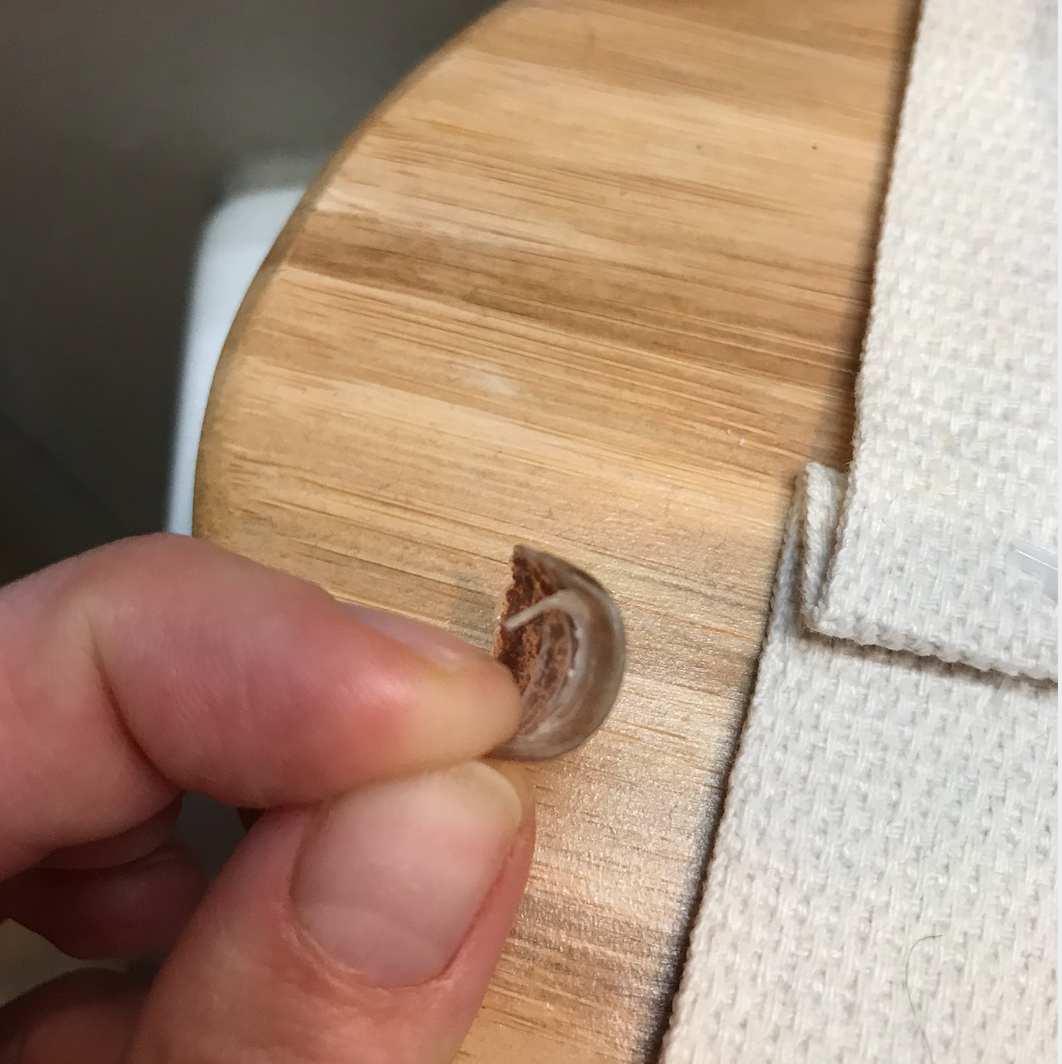
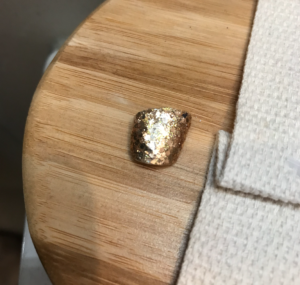 We recently had a patient come in who was experiencing her very first ingrown toenail – and initially, the cause of it was a bit of a mystery. She had relatively flat nails (compared to the typical excessively curved nails we often see with ingrown toenails), her shoes were roomy and spacious at the toe box – she didn’t like shoes that cramped her toes. Her foot posture and gait pattern were also relatively neutral – we didn’t see any excess pronation (rolling inwards) that places more pressure down the inside of the toe with every step that can contribute to an ingrown toenail.
We kept asking questions and investigating… (after all, knowing why an ingrown toenail has occurred helps guide how we treat it and how we help you prevent it from happening again in the future) until our patient remembered something, and reached into her jacket pocket. And this is what she pulled out (image on right).
This is the shellac polish that she had applied at a nail salon two months ago. The polish had done a great job of staying on her toes for that long, but she recalled that about a week ago when she was in bed, she felt like her nail was falling off. Really, it was the shellac that was coming off – and taking some of the outer layers of her toenail with it.
She said when she reached down to feel it, it was barely hanging on by the side of the nail – so she gave it a quick (and somewhat painful) tug to rip it off. And suddenly, everything made sense…
We recently had a patient come in who was experiencing her very first ingrown toenail – and initially, the cause of it was a bit of a mystery. She had relatively flat nails (compared to the typical excessively curved nails we often see with ingrown toenails), her shoes were roomy and spacious at the toe box – she didn’t like shoes that cramped her toes. Her foot posture and gait pattern were also relatively neutral – we didn’t see any excess pronation (rolling inwards) that places more pressure down the inside of the toe with every step that can contribute to an ingrown toenail.
We kept asking questions and investigating… (after all, knowing why an ingrown toenail has occurred helps guide how we treat it and how we help you prevent it from happening again in the future) until our patient remembered something, and reached into her jacket pocket. And this is what she pulled out (image on right).
This is the shellac polish that she had applied at a nail salon two months ago. The polish had done a great job of staying on her toes for that long, but she recalled that about a week ago when she was in bed, she felt like her nail was falling off. Really, it was the shellac that was coming off – and taking some of the outer layers of her toenail with it.
She said when she reached down to feel it, it was barely hanging on by the side of the nail – so she gave it a quick (and somewhat painful) tug to rip it off. And suddenly, everything made sense…
How Did Shellac Cause An Ingrown Toenail?
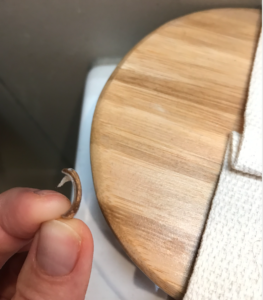
 In this case, it wasn’t necessarily the Shellac on its own, but how the tough Shellac substance gripped firmly onto the nail and then pulled the surface layers of the nail off, peeling them away until it got down to the side of the nail. Here, it was hanging on, and our patient pulled it off – much like how many people choose to pull the nail as an alternative to using proper nail trimming instruments – a very common cause of ingrown nails.
By pulling the nail off, it left behind a sharp nail spicule down the side of the nail – and it even left a similar sharp spicule of the natural nail that had been pulled off by the shellac – you can see it in the picture below.
When a sharp nail spicule is left behind down the side of the nail, invisible to the naked eye, as the nail naturally grows out, it can grow into the surrounding skin and cause an ingrown toenail. Unfortunately, this tends to get worse as the nail grows, not better.
In this case, it wasn’t necessarily the Shellac on its own, but how the tough Shellac substance gripped firmly onto the nail and then pulled the surface layers of the nail off, peeling them away until it got down to the side of the nail. Here, it was hanging on, and our patient pulled it off – much like how many people choose to pull the nail as an alternative to using proper nail trimming instruments – a very common cause of ingrown nails.
By pulling the nail off, it left behind a sharp nail spicule down the side of the nail – and it even left a similar sharp spicule of the natural nail that had been pulled off by the shellac – you can see it in the picture below.
When a sharp nail spicule is left behind down the side of the nail, invisible to the naked eye, as the nail naturally grows out, it can grow into the surrounding skin and cause an ingrown toenail. Unfortunately, this tends to get worse as the nail grows, not better.
How Was This Ingrown Toenail Treated?
For this patient, we treated her ingrown nail using our conservative treatment method. This is a simple method we use for first-time ingrown toenails where the cause is something that is a one-off, and that isn’t likely to happen again. It doesn’t require any anaesthetic and involves our podiatrists using specialised tools to trim the nail to safely and effectively remove the nail spicule.
Once the spicule is gone and nothing is pressing into the skin anymore, the pain and swelling can settle, and we would expect it to clear completely within a few days, after the wound from the ingrown nail has closed.
Recommendations For This Patient With Shellac For Next Time
We discussed a range of ways to prevent this from happening again – both relating to the Shellac, and to other factors, too. One thing we noted is that the shellac had been on for two months or even a little bit longer. As the shellac was thick and heavy, this contributed to its strong attachment to the nail and why it tore at the nail layers. We agreed that polish should only be kept on for a few weeks at a time to prevent this from happening again, and should be removed safely.
If you’re struggling with ingrown toenails resulting from using shellac or visiting a nail salon, we can help. Book your appointment by calling 09 523 2333 or book online here.

There’s a lot of information out there about ingrown toenails, and unfortunately, some of it is not accurate. Which, when you’re struggling with an ingrown nail and the methods you’re reading online aren’t working, can be very frustrating, disheartening, and painful.
So today, we’ve debunked some of the top ingrown nail myths that we hear regularly from our patients – many of whom have tried treating their ingrown toenail on their own for weeks first, without success.
1. It’s Not An Ingrown Nail Unless It’s On The Big Toe
This one stems from many people being unsure of the cause of their toe and toenail pain on their smaller toes, despite having similar signs and symptoms to previous ingrown nails they’ve had on their big toe. The truth is:
- Yes, you can absolutely develop ingrown toenails on the lesser toes, and we see this often
- The side of the toe is likely to appear red and swollen, and pushing on the area will elicit pain
- As the nail is so much smaller, it’s usually a very quick and easy fix
- Some of the time, there’s notable debris built up in the side of the nail (including discharge from the nail piercing the skin) that when removed, can instantly feel significantly better
2. Cutting a ‘V’ In The Centre Of Your Nail will Fix An Ingrown Toenail
While it is true that other cells in the body work by ‘coming together’ during repair and therefore could hypothetically ‘pull away’ from the sides of the ingrown toenail, unfortunately that’s not how the nail cells work or grow. Your nail grows in only one direction – out. What you do to the ends of your toenails doesn’t change this – nor does it change the painful nail spicule that is embedded into your skin when you have an ingrown nail.
We recommend saving yourself the hassle – and the potential of shredding through socks and hosiery with your sharp nail edges after a ‘V’ cut out.
3. Ingrown Toenails Are Only For School-Aged Children & Above
It makes sense that this sounds viable, after all, school comes with strict shoe requirements that kids must stay in all day everyday, and footwear is a primary cause of ingrown toenails. While it’s true that we see a lot of ingrown nails in school-aged children, we also see them in babies and toddlers too! If your young child has a red and swollen toe, or it looks like they have an ingrown toenail, bring them in for an appointment.
4. An Ingrown Toenail Will Get Better On Its Own
Think of an ingrown toenail like a sharp, big splinter – but instead of disappearing into the skin, being attached to your nail means that it continues to pierce through, growing as your nail grows, and leaving a painful, open wound where it has pierced the skin (which is vulnerable to infection). This is not something that goes away or just gets better on its own – not without removing the painful nail spicule first.
There are definitely things you can do to help relieve your painful symptoms – soaking the nail, taking painkillers, taking antibiotics, but none of these actions remove the nail from the skin.
5. Antibiotics Will Fix An Ingrown Nail
Antibiotics are a fantastic medication for managing infections. And if you have an infected ingrown toenail, it’ll do a great job to kill that bacteria and give you relief. But what antibiotics don’t do is remove hard, sharp pieces of nail from the skin – which is the only way to truly fix an ingrown toenail.
Unfortunately, many people are simply given antibiotics from their GPs and told to wait it out and soak their toes, which while it can give them some much-needed relief from their painful symptoms, that relief is only temporary as the nail is still lodged in the skin. Having the ingrown nail removed will give you symptom relief and prevent it from continuing to bother you.
6. Ingrown Nail Surgeries Leave Ugly Looking Nails
It makes sense to think that when part of your nail is removed as part of a partial nail avulsion procedure to permanently fix ingrown toenails, that your nail will be left looking less than ideal. But as a clinic that specialises in ingrown toenail surgery, we only remove the very bare minimum of the edge of your nail so that the difference is barely noticeable. The only difference is that your nail will appear to have a very straight nail edge, instead of one that curves down the side.
Our podiatrist will be able to explain exactly how much of the nail we’ll need to remove at your appointment, and what cosmetic results you can expect.
Got Any More Ingrown Nail Questions?
We’re here to help – email them to us at info@performpodiatry.co.nz and we’ll get back to you as soon as possible. To book a consultation for your ingrown nail, call us on 09 523 2333 or book online here.

So you’ve got toe pain starting but you’re not sure if it’s an ingrown toenail. What are the signs you should be looking for if it’s an ingrown toenail and what else could be the cause of your toe pain? Our ingrown nail specialists share what we look for in an early ingrown toenail.
What Does An Ingrown Toenail Look Like In The Early Stages?
When an ingrown nail first starts, it means that a sharp edge or spicule from the nail has recently pierced and penetrated the skin next to the spicule – even just slightly. This means that when any pressure is put on the nail, whether from being squeezed, from footwear, or even the natural vibrations through the feet when we walk, we can feel pain or discomfort. As the nail spicule has only recently pierced the skin, the skin surrounding the nail may not be red or inflamed, like is typically pictured in images of ingrown nails.
The location of the nail spicule may be deep down in the nail, or toward the top of the nail in the corner – this really depends on where the spicule or sharp edge developed. Often, the spicule is deep down the side of the nail, deeper than the eye can see, meaning at the early stages it’s barely noticeable. What may give an ingrown toenail away in the early stages in a build-up of callus down the side of the nail – this can indicate that the nail edge has been rubbing against the skin for some time, and has finally penetrated.
All in all, an ingrown nail in the early stages may not look so different from an unaffected nail. You can still have an ingrown toenail without any bleeding, swelling, redness or any discharge from the toe. The key is the pain when pinching the toe – if you get sharp, localised pain when pinching the toe, it could be the start of an ingrown toenail.
When Ingrown Nails Get Worse
As your ingrown nail gets worse, you can expect to see swelling and redness. The swelling is a catch-22 – the more swelling, the more the skin pushes against the nail and the deeper the nail enters the skin, which causes more swelling. The swelling will be present on the side of the nail where the nail has grown into the skin. If you have swelling on both sides of the nail, two of the sides have ingrown, which is not uncommon if the cause of the ingrown toenail is linked to a curved nail shape, among other causes. Sometimes, multiple toes can have ingrown toenails at the same time.
You may also notice:
- Increasing pain at the toe, especially when squeezed
- It becomes difficult to wear tighter shoes that push on the toes
- Clear or yellow discharge from the ingrown nail site, which can indicate an infection
- Bleeding from the ingrown nail site
If It’s Not An Ingrown Toenail, What Else Could It Be?
While ingrown nails are usually distinctive and common, similar toe pain can also because by:
- Callus build up on the toe, by the nail, but without the nail piercing the skin
- A foreign body like a splinter piercing the skin at the toe
- Damage to the nail and nail bed from trauma – like from stubbing your toe
- Toe fracture, which affects the toe bone beneath
- A cyst or a clogged sweat gland may be present in the area
What Should I Do If I Think I Have An Early Stage Ingrown Toenail?
An ingrown toenail caught in the early stages is the perfect time to nip it in the bud and treat it – before it gets worse. Leaving an ingrown toenail without care will lead to the inevitable – as your toenail naturally grows, the nail spicule or sharp edge will grow deeper into the skin, amplifying your symptoms. Treating it early saves you a lot of pain from the inflammation and symptoms that follow.
Treating your ingrown toenail should be done professionally – and is our area of expertise. We love early ingrown toenails because thanks to our state-of-the-art tools, we can get it quickly, safely, easily and relatively painlessly compared to a late-stage ingrown toenail. If you’re concerned about pain, we also have the option of numbing the area too.
We’ll also discuss the likely reasons that your ingrown nail has occurred, and what you can do to reduce the likelihood of it happening again in the future. We also have permanent treatments to stop the nail edge from growing back into the skin – we’ll discuss all your options at your consultation.
Book your appointment by calling us on 09 523 2333 or book online.
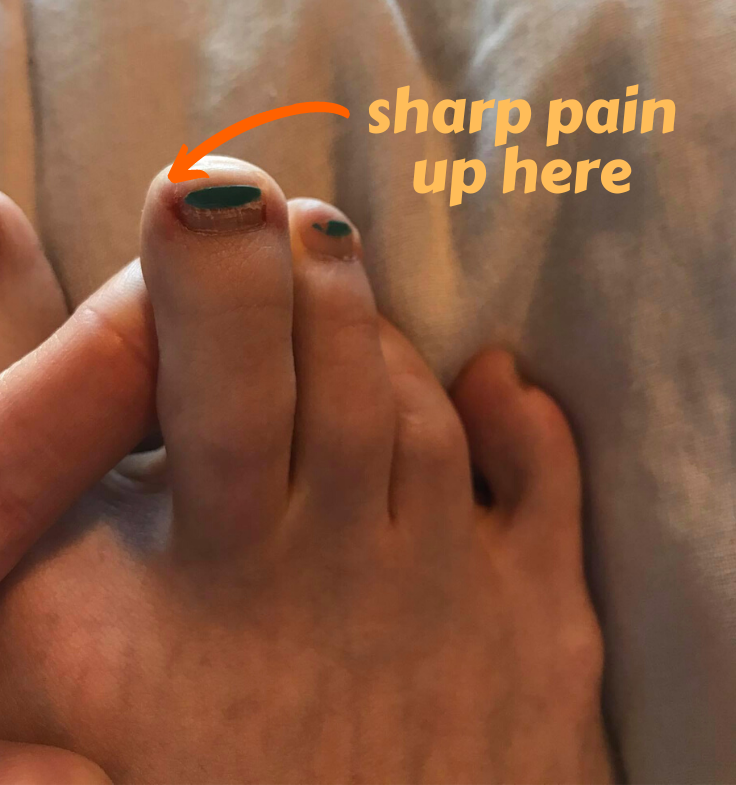
We had a patient come in to see us recently with the tip of her second toe being red, feeling tender and looking a little swollen. She had experienced ingrown toenails previously, and said it felt a little bit like that. Except this time, she had cut her toenails short a week or so prior – and the area that was painful wasn’t immediately down the side of her nail but above it, where the nail used to be before she cut it.
She wasn’t sure what was going on, if it was an ingrown nail, or if it was something else. We thought we’d share what happened in case you’re also feeling like you’ve got pain towards the top of your toe but your nails are trimmed short and the area of the pain isn’t where you’d expect, so you’re wondering whether it could still be an ingrown toenail or what could be causing your toe pain.
The actual toe pictured below (just for reference), about a week after we successfully treated it:
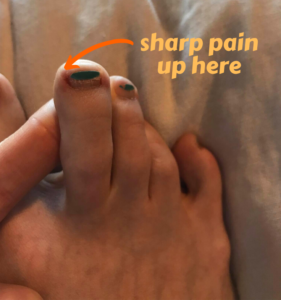
Second toe pain: Our patient’s story
When we examined her toe, it was extremely tender to touch in a particular spot only – and it wasn’t the toenail. (Note: pushing down on the toenail did cause a bit of pain, but only from the way that the pushing affected the painful area at the top of the toe). There was a small indent at the top of the toe where the pain was, and the entire tip of the toe was a little reddened and mildly swollen. Very tender to touch.
Examining the part that had indented, we found two things:
- A small corn in the crease – the skin was harder and firmer than the soft surrounding skin
- A small piece of the nail that had embedded into the nail crease – the crease created in the skin from the previous length of the toenail before it was trimmed
Understanding how this develops, we could see that the nail must have been rubbing against the skin when it was long for some time, which both produced the corn, and encouraged the edge of the nail to become embedded into the skin. Eventually, a small piece of the embedded nail broke off, and was left behind as it was trimmed.
Instant pain relief from treatment
If there’s anything good to come out of this case, it’s that for this patient, her treatment was quick and effective, with the sharp stabbing pain easily instantly after we removed both the embedded nail spicule and the small corn. This is because the swelling, redness and pain was a direct result of the nail spicule still being left behind, which was then made worse by the corn – so once we could remove both of these, the toe would be able to heal and any swelling and pain would subside.
This is a common mistake we see when patients treat their nails at home – they may trim their nails, but forget that while something foreign (and sharp!) is piercing the skin, the wound cannot close and heal. Getting it out can be tricky because the nail spicule can be difficult to see, difficult to remove, and painful when you’re using whatever you have at home to try to help, instead of our fine, specialised podiatric tools.
Within 5 minutes, we were able to remove the nail spicule, remove the corn completely, and then dress the toe. Our patient had immediate relief from the sharp stabbing pain, and while some tenderness lingered as there was still a small wound there, this had subsided by the next morning, along with the redness and swelling.
Our podiatrists make treating all sorts of ingrown toenails easy
We wanted to share this because while many ingrown toenails are ‘textbook’ – big toenail, down the side of the toe – as ingrown toenail specialists, we see plenty of ingrown toenails that are atypical, but that are still very effectively and simply treated.
We’re equipped with all the right tools to make treatment easy and stress-free, and unless you require ingrown nail surgery, can almost always treat and relieve your pain on the day. (If you require surgery we’ll always book you in for it as quickly as possible!).
Book your appointment with us by calling 09 523 2333 or book online here.

So you currently have – or have recently had – an ingrown toenail. And now you’ve developed some foot or leg pain. What’s going on and could they be linked?
How Ingrown Toenails Affect Your Feet
First thing’s first: ingrown toenails typically do not cause foot pain. Their pain is usually limited to the toe (often the big toe) that is affected, with the occasional throb radiating out from the toe – but not too far. With that said, ingrown toenails can lead to foot pain by:
Changing the way you walk
When you have an ingrown toenail, you may be changing the way you walk to minimise your pain from your ingrown toenail without even knowing it. This is known as guarding and is the same as walking on the outside of your foot when something is sore on the inside of your foot. As you change the way you walk to avoid or reduce the pain felt from the ingrown toenail, your gait changes, and so does the way your muscles are used with every step. Some muscles will have to work harder, and may become overused. Some areas of your foot may now also be taking on more pressure, and may get sore too.
Before you know it, you’ve got foot pain – and depending on how severe it is, you may need to treat this cause of foot pain too, alongside your ingrown toenail. This is why we always recommend getting your ingrown toenail treated ASAP – and why procedures like a partial nail avulsion that keeps ingrown toenails gone for good are often performed.
Be mindful of infections
If your ingrown toenail has become infected, and the infection is severe enough, it may also be a cause of pain in the foot. In these cases, you’ll likely notice the redness around your toe creeping up the foot. This can get serious quickly – so make sure you see your GP or podiatrist ASAP, there’s a good chance you will need antibiotics to help with the infection and then will need the nail treated quickly.
Could your footwear be the culprit?
We often see tight, narrow-fitting footwear as a culprit of ingrown toenails. This happens as the forefoot is squashed inside the shoe, and the result is that the nail is pushed into the surrounding skin. If this is the case, then it could also be possible that your tight footwear is also responsible for the foot pain you’re experiencing.
If you’re lucky, the problem will be minor and will quickly settle when you stop wearing the shoes. For some, their shoe wear is long enough to do damage to the feet as well as the nails, and they need care to rehabilitate their feet, too. Don’t worry about figuring this out – your podiatrist will help explain this to you and determine what factors caused it.
Our Podiatrists Can Help With Both Ingrown Nails & Foot Pain
The beauty of our clinic here at the Auckland Ingrown Toenail Clinic is that we’re part of Perform Podiatry – Auckland’s leading podiatry clinic. This means that we can not only treat your ingrown toenail – but assess, diagnose and care for your foot pain too.
If you’ve got foot pain after, or at the same time as an ingrown toenail, we can help. Book your appointment online with us here or call us on 09 523 2333.

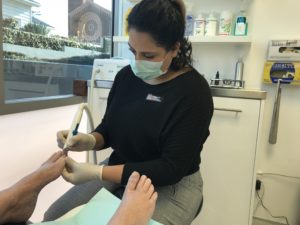 Ever wish you knew someone that has gone through the same procedure as you so you knew what to expect? We absolutely get it – and while ingrown toenail surgeries are common enough these days that you’ll likely know someone that has had it done – it’s also not the type of thing that many go bragging to their friends about. So, we’ve shared the experience for you!
Here’s the low-down on what having an ingrown toenail surgery with the Auckland Ingrown Toenail Clinic is really like, as told retrospectively by one of our patients.
Choosing the Auckland Ingrown Toenail Clinic
I found the ingrown toenail clinic, and hence Perform Podiatry, on Google. They weren’t too far away, they had good reviews, and I liked that the podiatrist I’d be seeing would be very experienced in ingrown toenails. The website also mentioned an all-inclusive price – I know multiple appointments with health professionals can add up quickly, so knowing the full cost was great.
The First Appointment
I decided to see someone about my ingrown toenail because this was my third ingrown in the last 4 or so years. I was over the pain and wanted it fixed by a professional. I called in the afternoon and got an appointment for the next day.
The first part of the appointment was easy. The podiatrist checked my nail and asked a bunch of questions. She told me that I had multiple options, and what each involved. One option was to remove the piece of nail that was causing me pain right there and then. I was told that was good for those who have never had an ingrown nail before, as it may not come back. I knew I needed something permanent so I wouldn’t have to deal with this nail in the future.
One of the other options was a procedure called a partial nail avulsion. It’d be done in under an hour, it was permanent (or they’d re-do it), I’d need minimal time off work, and I met their criteria for the procedure. This was what I’d wanted.
The Procedure
I booked in to have the procedure the next day as it’d be a Friday and I’d have the weekend to take it easy.
When I arrived, the room was already “set up” – very clean and with the equipment ready. The same podiatrist that I saw the day before cleaned my toe with iodine and the worst part of the procedure was done – the anaesthetic. It worked, my toe was numb, and the only thing I felt for the rest of the time was pressure.
They showed me the piece of nail they removed – it was bigger than I thought. It looked like I had cut the nail but missed the part right at the end and just pulled the nail off, leaving a big piece in.
They put a bunch of bandages on my toe to protect it. The whole process was done in about 45-50 minutes. I was given instructions to come back on Monday, NOT get the toe wet in any way, not wear tight shoes, rest the foot and put it on a pillow on the couch, and that if it becomes painful to take some specific painkillers. I did take some Friday night as my toe throbbed after the anaesthetic wore off but didn’t take any more after that. I didn’t do too much on the weekend, and avoided putting on closed shoes as that’d hurt the toe.
The Check
At Monday’s appointment, I got a bag filled with the same dressings they used. They removed my dressings to check how the toe was going (which seemed fine) and taught me how to dress it again. I was told to re-dress it anytime it got wet and every few days for the next week. I was to come back in another week to check that it was healing nicely. I went back to work that week and wore shoes that didn’t press on my toe. I redressed as instructed.
A week later I came back and was told that as everything had closed over nicely, I could change the dressings as the infection risk was minimised. The toe was still a bit pink and I could see the dried blood etc, but it wasn’t painful as long as I didn’t hit it/push against it and I was told it was healing nicely, and to let the podiatrist know if anything changed.
The Result
About 7 or so weeks later the toe was pretty much back to normal. The nail was a little smaller, but not by much and you can’t really tell unless I point it out. The nail edge is just very smooth and straight and doesn’t curl down into the side so much. Am now looking forward to not having any problems with my toenail!
Ever wish you knew someone that has gone through the same procedure as you so you knew what to expect? We absolutely get it – and while ingrown toenail surgeries are common enough these days that you’ll likely know someone that has had it done – it’s also not the type of thing that many go bragging to their friends about. So, we’ve shared the experience for you!
Here’s the low-down on what having an ingrown toenail surgery with the Auckland Ingrown Toenail Clinic is really like, as told retrospectively by one of our patients.
Choosing the Auckland Ingrown Toenail Clinic
I found the ingrown toenail clinic, and hence Perform Podiatry, on Google. They weren’t too far away, they had good reviews, and I liked that the podiatrist I’d be seeing would be very experienced in ingrown toenails. The website also mentioned an all-inclusive price – I know multiple appointments with health professionals can add up quickly, so knowing the full cost was great.
The First Appointment
I decided to see someone about my ingrown toenail because this was my third ingrown in the last 4 or so years. I was over the pain and wanted it fixed by a professional. I called in the afternoon and got an appointment for the next day.
The first part of the appointment was easy. The podiatrist checked my nail and asked a bunch of questions. She told me that I had multiple options, and what each involved. One option was to remove the piece of nail that was causing me pain right there and then. I was told that was good for those who have never had an ingrown nail before, as it may not come back. I knew I needed something permanent so I wouldn’t have to deal with this nail in the future.
One of the other options was a procedure called a partial nail avulsion. It’d be done in under an hour, it was permanent (or they’d re-do it), I’d need minimal time off work, and I met their criteria for the procedure. This was what I’d wanted.
The Procedure
I booked in to have the procedure the next day as it’d be a Friday and I’d have the weekend to take it easy.
When I arrived, the room was already “set up” – very clean and with the equipment ready. The same podiatrist that I saw the day before cleaned my toe with iodine and the worst part of the procedure was done – the anaesthetic. It worked, my toe was numb, and the only thing I felt for the rest of the time was pressure.
They showed me the piece of nail they removed – it was bigger than I thought. It looked like I had cut the nail but missed the part right at the end and just pulled the nail off, leaving a big piece in.
They put a bunch of bandages on my toe to protect it. The whole process was done in about 45-50 minutes. I was given instructions to come back on Monday, NOT get the toe wet in any way, not wear tight shoes, rest the foot and put it on a pillow on the couch, and that if it becomes painful to take some specific painkillers. I did take some Friday night as my toe throbbed after the anaesthetic wore off but didn’t take any more after that. I didn’t do too much on the weekend, and avoided putting on closed shoes as that’d hurt the toe.
The Check
At Monday’s appointment, I got a bag filled with the same dressings they used. They removed my dressings to check how the toe was going (which seemed fine) and taught me how to dress it again. I was told to re-dress it anytime it got wet and every few days for the next week. I was to come back in another week to check that it was healing nicely. I went back to work that week and wore shoes that didn’t press on my toe. I redressed as instructed.
A week later I came back and was told that as everything had closed over nicely, I could change the dressings as the infection risk was minimised. The toe was still a bit pink and I could see the dried blood etc, but it wasn’t painful as long as I didn’t hit it/push against it and I was told it was healing nicely, and to let the podiatrist know if anything changed.
The Result
About 7 or so weeks later the toe was pretty much back to normal. The nail was a little smaller, but not by much and you can’t really tell unless I point it out. The nail edge is just very smooth and straight and doesn’t curl down into the side so much. Am now looking forward to not having any problems with my toenail!
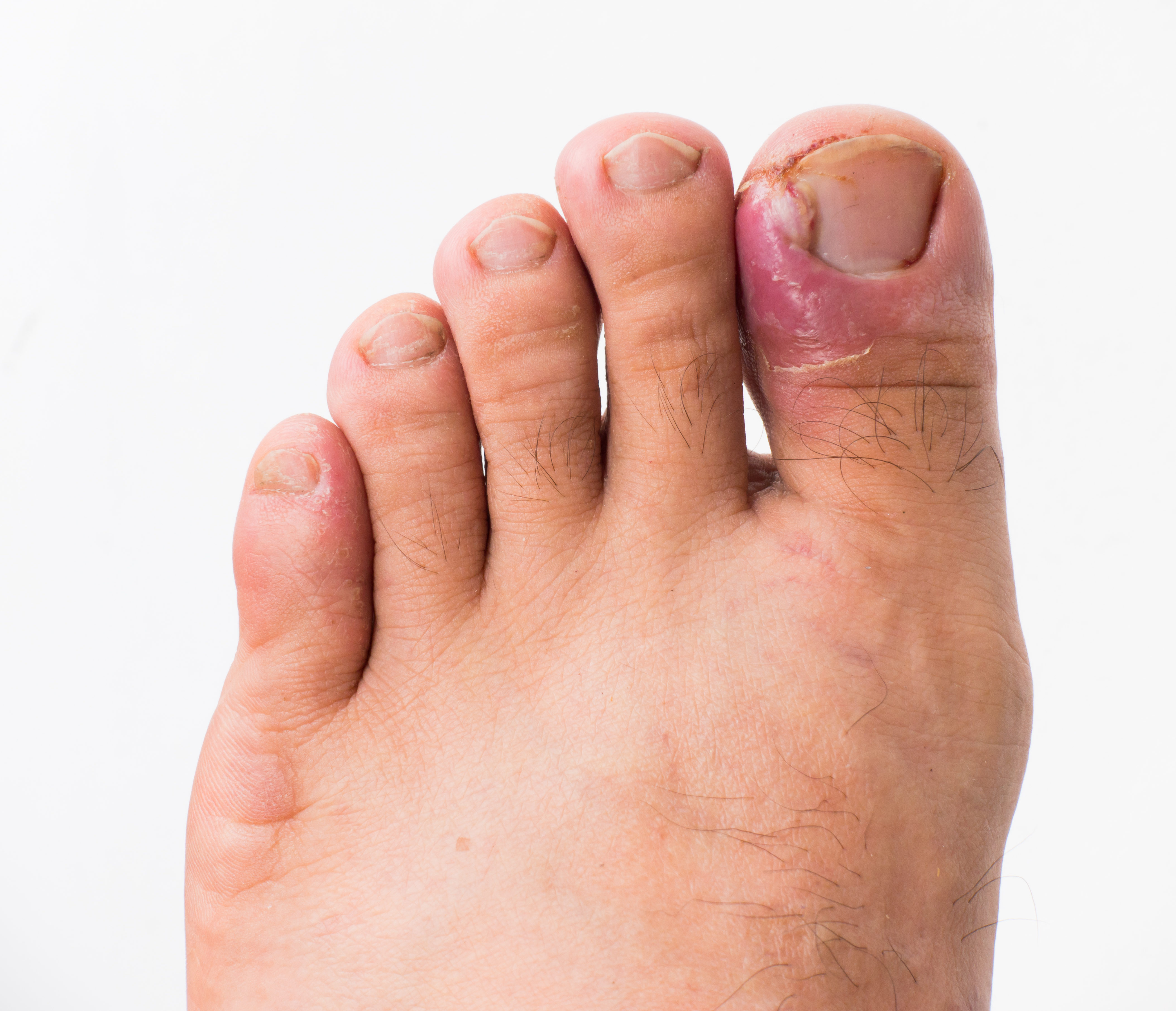
Ingrown toenails are painful and frustrating enough, so the last thing you want is to add an infection to the mix. Unfortunately, in our experience, a large number of ingrown toenails will get infected if proper treatment is undertaken – and it makes sense when you think about it.
Today, our ingrown toenail specialists will be sharing:
- Why the risk of developing an infection once you have an ingrown toenail is high
- What you can do to prevent an infection before it develops
- How you can treat your ingrown toenail and infection once it has occurred
You Have A Significant Risk Of Developing An Infection. Here’s Why
Let’s clear something up: ingrown toenails and infections are not a case of the chicken and the egg – the ingrown toenail comes first.
What classifies a sore toe as an ‘ingrown toenail’ is the moment that the sharp piece of nail goes from merely pushing against the surrounding skin, to actually piercing it and penetrating it.
Think about that for a second – you have a piece of nail that is now constantly inside the skin through a cut down the side of the nail. Every time you walk and move, it’ll move slightly with vibrations of pressures from shoes and socks. Ouch! This also means that while a normal cut occurs and then can heal, this cut can’t – because the ingrown toenail is still constantly piercing it and so keeping the cut open.
An infection occurs when bacteria and other nasties enter the body. Usually, our skin is a fantastic barrier, so while there may be many nasties around us regularly, they never have an ‘in’. Until now. And especially at the ground where you may walk barefooted. And when you give it a perfectly placed entrance – there’s a strong chance that the infection will take hold and start to develop.
Once the infection takes hold, it means increased swelling, pain and oozy discharge (and maybe blood) that is yellow/green/clear in nature and may ‘crust over’.
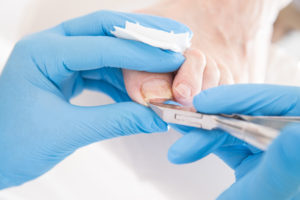
Preventing An Infection From Your Ingrown Toenail Before It Develops
So how, then, can we prevent – or at least reduce the risk – of developing an infection? It’s quite simple, really. And no – no Epsom salts required just yet!
As the cut from ingrown toenail creates an ‘in’ for the bacteria to take hold, the way to prevent an infection is to remove this ‘in’. This means removing the penetrating nail edge so that the cut can heal, close, and no longer be vulnerable to the infection. Simple, right? – Absolutely.
So How Do I Treat My Ingrown Toenail – And The Infection If I Already Have One?
The best way to ensure the proper care of your ingrown toenail is to see your Podiatrist. Our team here at the Ingrown Toenail Clinic are Podiatrists that are trained in simple and painless ingrown toenail surgeries, as well as conservative care where we safely remove that small, pesky nail edge in a matter of minutes. You’ll feel the relief almost instantly!
We don’t recommend trying to cut back the nail at home because often the nail runs much deeper than you can see, so most people will miss removing the complete penetrating edge and their pain will only continue to worsen. You also won’t have the right tools for the job – whereas we have everything needed to do it quickly and easily – even anaesthetic if you need or want it! (though most people don’t).
Once the sliver of nail is removed, the body will be able to effectively heal the wound and fight the infection – and of course, we’ll help it along by dressing it with betadine (antiseptic). You’re welcome to soak it in some Epsom salts too – but once the nail is out, it should be relatively simple and straightforward for it to heal and the infection to subside.
No more painful, swollen discharge – hooray!

Auckland’s Ingrown Toenail Experts
We’re proud to be Auckland’s only Podiatry clinic that specialises in the safe and effective care of ingrown toenails – and we do a really good job of it. From simple and easy care to quickly remove the small nail edge, to minor nail surgery to permanently correct ingrown toenails, we’ve got you covered.
You can book online here or give us a call on (09) 523 2333.
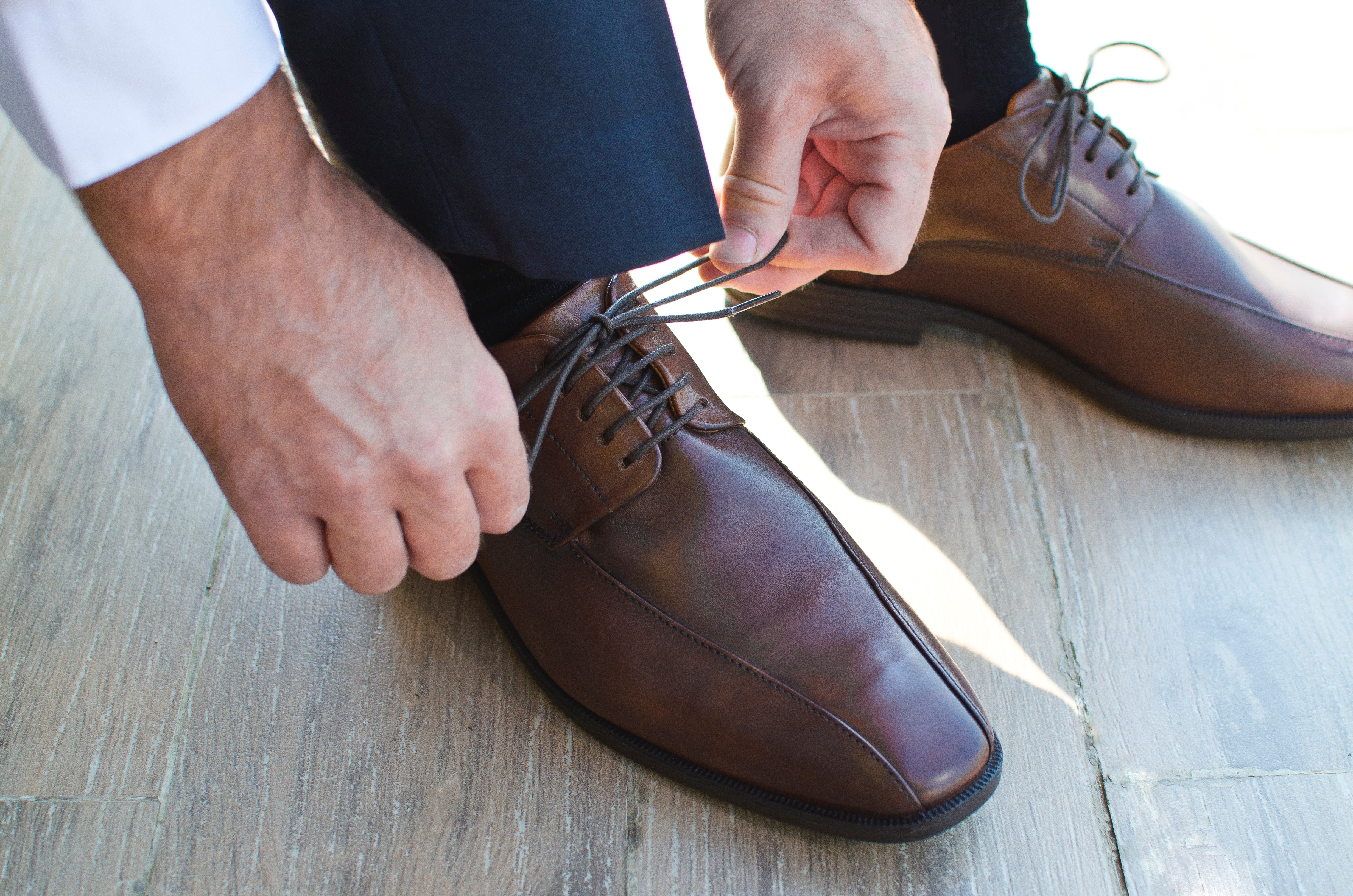
If you aren’t already aware: tight, narrow and poorly-fitting footwear is a major cause of ingrown toenails for young and old alike. Other major causes include:
- Improper nail cutting technique (curving the sides of the nail or ‘picking’ the nails off instead of cutting them
- Genetic predisposition (the shape of the toenail or the thickness of the skin surrounding the nail)
- Damage to the nail (dropping something on the nail or stubbing your toe)
But WHY and HOW do shoes cause ingrown toenails?
It’s pretty simple really:
1. Your foot and toes are crammed into a shoe that is too tight or narrow
2. The pressure on the side of your big toe pushes the skin on the sides of the nail into the nail
3. The close proximity of the skin and nails means that the nail pierces the skin
4. Ouch! Pain, swelling, redness (and sometimes a little bleeding)
5. The swelling means that the nail and skin are now in even closer proximity and the nail will continue to push into the skin
6. As long as there is the ‘cut’ (open wound), the toe is vulnerable to infection
7. An infection will cause further swelling and pain, making it even worse
8. The cut where the nail pierced the skin will not be able to heal until the nail is no longer present in the skin
 Makes sense, right?
Makes sense, right?
Now let’s quickly touch back on all-important point number 8. If any part of the nail continues to penetrate the nail – or even move inside when you take a step and push your toes against the ground – then it won’t be able to heal or ‘go away its own’.
That’s why it’s so important to have the nail effectively treated to make sure the nail spicule is removed so that the healing process can begin. Until the wound closes, it stays vulnerable to picking up an infection which is a big no-no and can put you at risk of serious (and painful) complications.
Let us help you!
This is where we come in! We’ll remove your painful nail spicule, look at what the cause of your ingrown toenail was and how we can get it to not come back in the future. Yay! We see so many ingrown toenails every day that this has become our specialty and we make the process as easy and stress-free as possible.
You can get in touch with our team by calling 09 523 2333. We’re happy to answer any questions you may have. You can also book in online by clicking here. And in the meantime, if you’re prone to getting ingrown toenails, please be mindful of wearing tight, narrow or ill-fitting footwear and just stay clear of it!
– The Auckland Ingrown Toenail Team
 We have the pleasure of seeing and treating a lot of ingrown toenails. That’s not sarcastic at all – successfully treating ingrown toenails provides an immense amount of relief to suffering patients and using our skills to do this successfully is something we’re very proud of.
There’s a common theme to many of the first visits we have with our patients, however, that we thought we’d shed some light on in case you happen to find yourself in this boat too. This theme is the I-googled-it-so-it-must-work home remedies for ingrown toenails.
Now, don’t get us wrong. Some of the strategies you try may well alleviate your pain and have you feeling much better. There’s almost always a catch though: It’s temporary.
We have the pleasure of seeing and treating a lot of ingrown toenails. That’s not sarcastic at all – successfully treating ingrown toenails provides an immense amount of relief to suffering patients and using our skills to do this successfully is something we’re very proud of.
There’s a common theme to many of the first visits we have with our patients, however, that we thought we’d shed some light on in case you happen to find yourself in this boat too. This theme is the I-googled-it-so-it-must-work home remedies for ingrown toenails.
Now, don’t get us wrong. Some of the strategies you try may well alleviate your pain and have you feeling much better. There’s almost always a catch though: It’s temporary.
Repeated ingrown toenail occurrence
The unfortunate truth is that if you’ve suffered from the terrible pains of ingrown toenails more than once, the reality is that you’re almost definitely going to suffer from them again. One-off ingrown toenails absolutely do occur, but the cause is usually a particular pair of tight shoes that push the nail into the skin and they don’t tend to occur again after you’ve stopped wearing them. Repetitive ingrown toenails are the best indicator that there’s something going on, that the nail has now started growing in an abnormal way that ends up penetrating the skin, and that it’s going to continue to happen.
So, why advise against home remedies?
The first reason is that without knowing exactly what you’re doing, you could be further encouraging the nail to continue to grow in a way that will cause you a tremendous amount of pain.
Take the way your nail is cut, for example. If you think that cutting down into the corner and removing the piece of nail will discourage it from growing there again – the reality is the exact opposite. Curving down and removing that painful nail edge will likely encourage the nail to keep curving a growing down – unless you know what you’re doing and understand the characteristics of nail growth.
The second reason is that as health professionals, we don’t want you to suffer with ongoing pain. Experiencing pain every 3 months from an ingrown toenail isn’t a great solution in our opinion, and especially not when you can have a one-time permanent procedure that will have you saying goodbye to ingrown toenails for good.
So, what is this procedure?
The procedure we’re talking about is called a partial nail avulsion (PNA). It involves removing a small part of the nail (the part that causes you pain!) and applying a chemical that will stop that small portion of nail from growing back and continuing to cause you grief, over and over again.
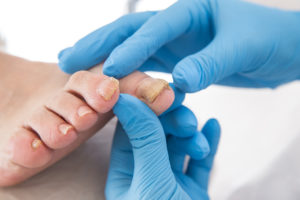 We love this procedure because:
We love this procedure because:
- It’s done simply and effectively in-clinic
- It’s completed in 60 minutes (with the procedure time typically around 20 minutes)
- It’s performed under local anaesthetic so is pain-free
- You do not need to take any additional time off work/school following the procedure & can go home immediately
- You don’t need any special boots or braces while the toe heals
- The procedure causes very little post-procedure discomfort
- We dress your toe, provide you with a take-home dressing pack & re-dressing instructions
- We monitor your progress to ensure it’s healing well
While we perform conservative one-off care for first-time ingrown toenails or those with a definitive cause that is not likely to recur, the PNA is our best recommendation for those that are repetitively putting up with and suffering from ingrown toenails. We have tremendous success with the procedure and have prevented hundreds of patients from continuing to regularly suffer. Our team are experts when it comes to ingrown toenails and we love seeing the difference that having this procedure makes in the lives of our patients.
For more information about the PNA procedure, click here. To book an appointment, you can give us a call on 09 523 2333 or book online.





 In this case, it wasn’t necessarily the Shellac on its own, but how the tough Shellac substance gripped firmly onto the nail and then pulled the surface layers of the nail off, peeling them away until it got down to the side of the nail. Here, it was hanging on, and our patient pulled it off – much like how many people choose to pull the nail as an alternative to using proper nail trimming instruments – a very common cause of ingrown nails.
In this case, it wasn’t necessarily the Shellac on its own, but how the tough Shellac substance gripped firmly onto the nail and then pulled the surface layers of the nail off, peeling them away until it got down to the side of the nail. Here, it was hanging on, and our patient pulled it off – much like how many people choose to pull the nail as an alternative to using proper nail trimming instruments – a very common cause of ingrown nails.




 Ever wish you knew someone that has gone through the same procedure as you so you knew what to expect? We absolutely get it – and while ingrown toenail surgeries are common enough these days that you’ll likely know someone that has had it done – it’s also not the type of thing that many go bragging to their friends about. So, we’ve shared the experience for you!
Ever wish you knew someone that has gone through the same procedure as you so you knew what to expect? We absolutely get it – and while ingrown toenail surgeries are common enough these days that you’ll likely know someone that has had it done – it’s also not the type of thing that many go bragging to their friends about. So, we’ve shared the experience for you!


 Makes sense, right?
Makes sense, right? We have the pleasure of seeing and treating a
We have the pleasure of seeing and treating a  We love this procedure because:
We love this procedure because: